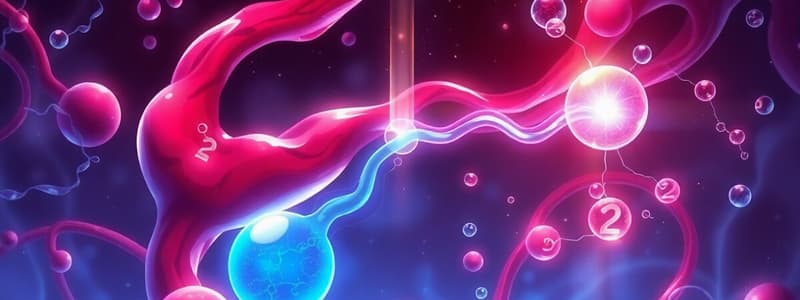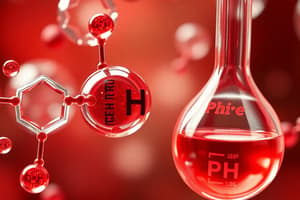Podcast
Questions and Answers
What is the normal pH range for blood?
What is the normal pH range for blood?
- 7.35 to 7.45 (correct)
- 7.5 to 8.0
- 7.0 to 7.2
- 6.0 to 6.5
Which system primarily acts as a buffer in the blood?
Which system primarily acts as a buffer in the blood?
- Hemoglobin Buffer System
- Protein Buffer System
- Bicarbonate Buffer System (correct)
- Phosphate Buffer System
How does the body respond to increased carbon dioxide levels?
How does the body respond to increased carbon dioxide levels?
- Increases bicarbonate production
- Decreases breathing rate
- Decreases carbonic acid production
- Increases breathing rate (correct)
Which of the following is NOT a mechanism the body uses for pH regulation?
Which of the following is NOT a mechanism the body uses for pH regulation?
What happens during acidosis when blood pH drops?
What happens during acidosis when blood pH drops?
What occurs during respiratory acidosis?
What occurs during respiratory acidosis?
Which buffer system is primarily active in the kidneys?
Which buffer system is primarily active in the kidneys?
How does the body maintain equilibrium during alkalosis?
How does the body maintain equilibrium during alkalosis?
What hormone is released by the pancreas to lower blood glucose levels?
What hormone is released by the pancreas to lower blood glucose levels?
What occurs when blood glucose levels drop significantly?
What occurs when blood glucose levels drop significantly?
What is the primary hormone responsible for raising blood calcium levels?
What is the primary hormone responsible for raising blood calcium levels?
What effect does baroreceptor activation have when blood pressure rises?
What effect does baroreceptor activation have when blood pressure rises?
When blood calcium levels are high, which hormone is released to lower them?
When blood calcium levels are high, which hormone is released to lower them?
How does the body respond when blood osmolarity increases due to dehydration?
How does the body respond when blood osmolarity increases due to dehydration?
What is the response of the body when blood pressure drops?
What is the response of the body when blood pressure drops?
What happens to insulin secretion as blood sugar levels drop?
What happens to insulin secretion as blood sugar levels drop?
What triggers the release of ADH from the pituitary gland?
What triggers the release of ADH from the pituitary gland?
What type of feedback mechanism is primarily responsible for maintaining homeostasis in the body?
What type of feedback mechanism is primarily responsible for maintaining homeostasis in the body?
How does low blood osmolarity affect ADH secretion?
How does low blood osmolarity affect ADH secretion?
Which physiological process is an example of negative feedback?
Which physiological process is an example of negative feedback?
Which physiological process is an example of positive feedback?
Which physiological process is an example of positive feedback?
What is the primary role of the hypothalamus in temperature regulation?
What is the primary role of the hypothalamus in temperature regulation?
What is the role of platelets in the positive feedback mechanism of blood clotting?
What is the role of platelets in the positive feedback mechanism of blood clotting?
In what situation is positive feedback most likely to occur?
In what situation is positive feedback most likely to occur?
Which hormone is released during lactation to support milk production?
Which hormone is released during lactation to support milk production?
What physiological action is triggered when the body temperature drops?
What physiological action is triggered when the body temperature drops?
What initiates the cascade of events in nerve signal transmission?
What initiates the cascade of events in nerve signal transmission?
What typically occurs when the stimulus for positive feedback is removed?
What typically occurs when the stimulus for positive feedback is removed?
How do modern medical interventions impact homeostasis?
How do modern medical interventions impact homeostasis?
Which of the following best describes the role of osmoreceptors in fluid balance?
Which of the following best describes the role of osmoreceptors in fluid balance?
What happens to blood glucose levels after eating?
What happens to blood glucose levels after eating?
What is the overall goal of feedback mechanisms in physiological processes?
What is the overall goal of feedback mechanisms in physiological processes?
What effect does hyperventilation have on blood pH?
What effect does hyperventilation have on blood pH?
In the case of alkalosis, what will the kidneys do to help restore pH balance?
In the case of alkalosis, what will the kidneys do to help restore pH balance?
What physiological process is primarily responsible for rapid pH regulation in response to carbon dioxide levels?
What physiological process is primarily responsible for rapid pH regulation in response to carbon dioxide levels?
How do the kidneys respond to metabolic acidosis?
How do the kidneys respond to metabolic acidosis?
What is the first step in the homeostatic control process?
What is the first step in the homeostatic control process?
Which factor does NOT directly affect the homeostatic process?
Which factor does NOT directly affect the homeostatic process?
What defines the response of the effector in the homeostatic system?
What defines the response of the effector in the homeostatic system?
How does the body regulate hydration levels in cells?
How does the body regulate hydration levels in cells?
Flashcards are hidden until you start studying
Study Notes
pH Regulation
- Maintaining a stable pH is critical for the human body, ensuring proper functioning of enzymes and biological processes.
- Normal blood pH range is 7.35 to 7.45, slightly alkaline.
- Deviations from this range can lead to enzyme denaturation, physiological dysfunction, and even death.
- The body uses multiple feedback mechanisms to maintain pH balance.
- Normal metabolism produces acidic waste products, constantly threatening the body's pH with shifts towards acidity.
Blood Buffering System
- The bicarbonate buffer system is a primary blood buffer, consisting of bicarbonate ions (HCO3-) and carbonic acid (H2CO3).
- In acidosis, bicarbonate absorbs excess hydrogen ions (H+), forming carbonic acid, which decomposes into water (H2O) and carbon dioxide (CO2).
- In alkalosis, carbonic acid dissociates to release H+, reducing pH.
- Protein buffer system involves proteins like hemoglobin, binding to or releasing hydrogen ions based on pH.
- The phosphate buffer system, active in the kidneys, regulates pH in intracellular and renal tubular fluids.
Respiratory System (Lungs)
- The lungs regulate pH by controlling CO2 levels.
- Increased CO2 in the blood leads to more carbonic acid, lowering pH (acidosis).
- The body responds by hyperventilation (increased breathing rate) to expel CO2 and raise pH.
- Decreased CO2 in the blood leads to a rise in pH (alkalosis).
- The body responds by hypoventilation (decreased breathing rate) to retain CO2 and lower pH.
- Holding breath or respiratory issues can lead to respiratory acidosis due to CO2 buildup.
- Hyperventilation can cause respiratory alkalosis due to excessive CO2 elimination.
Renal (Kidney) Regulation
- The kidneys fine-tune blood pH by excreting or retaining hydrogen ions (H+) and bicarbonate (HCO3-).
- In acidosis, kidneys excrete more H+ and conserve bicarbonate.
- In alkalosis, kidneys conserve H+ and excrete excess bicarbonate.
- This process is slower than respiratory regulation but provides a sustained response to pH imbalances.
- Kidney dysfunction or diabetes can lead to metabolic acidosis due to inability to remove excess acids.
- Vomiting or excess bicarbonate intake can cause metabolic alkalosis.
Control of Homeostasis
- The body's ability to regulate its internal environment, maintaining stability despite external variations.
- Homeostatic systems involve:
- Receptor: Detects changes in a variable.
- Control Center: Processes information and sends out commands.
- Effector: Responds to commands to restore balance.
- Feedback: The system receives input from its sensors and makes adjustments, either positive or negative, to maintain balance.
Negative Feedback
- The most common type of feedback, restoring balance by opposing deviations from the normal state.
- Reverses the direction of change, creating a stabilizing effect.
Positive Feedback
- Amplifies a response, pushing the system further from its normal state.
- Reinforces change, often leading to an endpoint or completion of a process.
Examples of Negative Feedback
Temperature Regulation
- The body maintains a core temperature around 37°C.
- Increased temperature triggers sweating and vasodilation to cool down.
- Decreased temperature triggers shivering and vasoconstriction to conserve heat.
Blood Sugar Regulation
- The pancreas controls blood glucose levels using insulin and glucagon.
- High blood sugar (hyperglycemia): Insulin promotes glucose uptake and storage, lowering blood glucose levels.
- Low blood sugar (hypoglycemia): Glucagon stimulates glucose release from the liver, raising blood glucose levels.
Blood Pressure Regulation
- The baroreceptor reflex governs blood pressure.
- High blood pressure triggers slowing of heart rate and dilation of blood vessels to lower pressure.
- Low blood pressure triggers increased heart rate and constriction of blood vessels to raise pressure.
Calcium Homeostasis
- Regulated by parathyroid hormone (PTH) and calcitonin.
- Low blood calcium: PTH stimulates calcium release from bones, absorption in intestines, and retention in kidneys.
- High blood calcium: Calcitonin inhibits calcium release from bones and promotes excretion by kidneys.
Regulation of Water Balance (Osmoregulation)
- Regulated by antidiuretic hormone (ADH).
- High blood osmolarity (dehydration): ADH promotes water reabsorption in kidneys to restore osmolarity.
- Low blood osmolarity (overhydration): ADH secretion is inhibited, leading to increased water excretion.
Examples of Positive Feedback
Labor and Childbirth
- Oxytocin release triggers uterine contractions, pushing the baby toward the birth canal, leading to more oxytocin release, amplifying contractions until birth.
Blood Clotting
- Platelet aggregation and release of chemicals at a wound site attract more platelets, accelerating clot formation until the wound is sealed.
Lactation in Nursing Mothers
- Suckling stimulates prolactin and oxytocin release, enhancing milk production and flow.
Nerve Signal Transmission (Action Potentials)
- Sodium ion influx triggers further sodium channel opening, rapidly propagating the action potential.
Factors Affecting Homeostasis
- Nutrition: Deficiencies in vitamins or minerals can disrupt cellular function.
- Toxins: Overexposure to drugs or other toxins can disrupt cellular and physiological processes.
- Psychological: Stress, anxiety, or negative emotions can negatively impact homeostasis, while relaxation and positive emotions can have beneficial effects.
- Physical: Adequate rest, sunlight exposure, and exercise contribute to proper function and resilience.
- Genetic/Reproductive: Genetic factors can influence an individual's ability to maintain homeostasis, while reproductive processes are critical for passing on genetic material and sustaining a population.
- Medical: Medications can have positive and negative impacts on homeostasis, with potential benefits and risks.
Cellular Malfunction and Homeostasis
- Disruption in cellular homeostasis can lead to various health issues or even disease.
- Lifestyle choices, environmental exposures, and external factors can influence the body's ability to maintain homeostasis.
Maintaining Homeostasis
- By removing negative health influences and providing adequate positive health influences, the body can better self-regulate and repair, maintaining homeostasis.
Studying That Suits You
Use AI to generate personalized quizzes and flashcards to suit your learning preferences.




